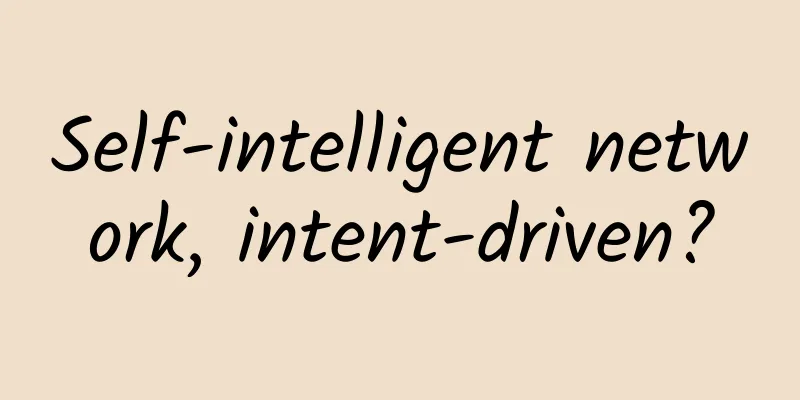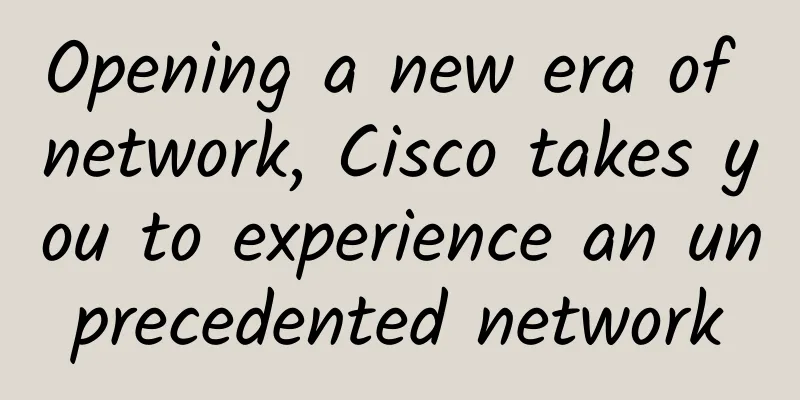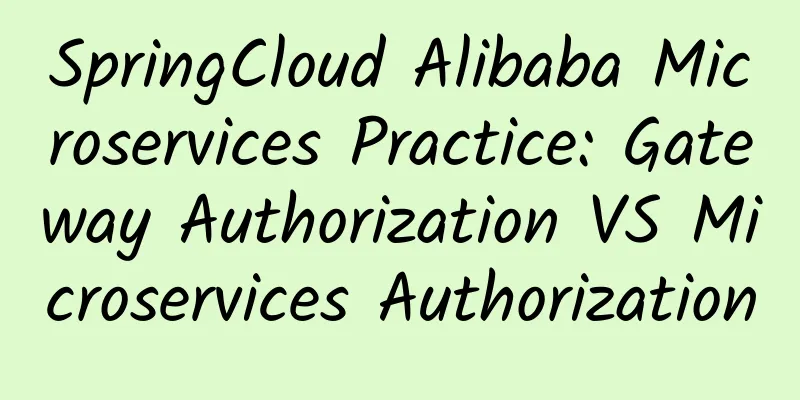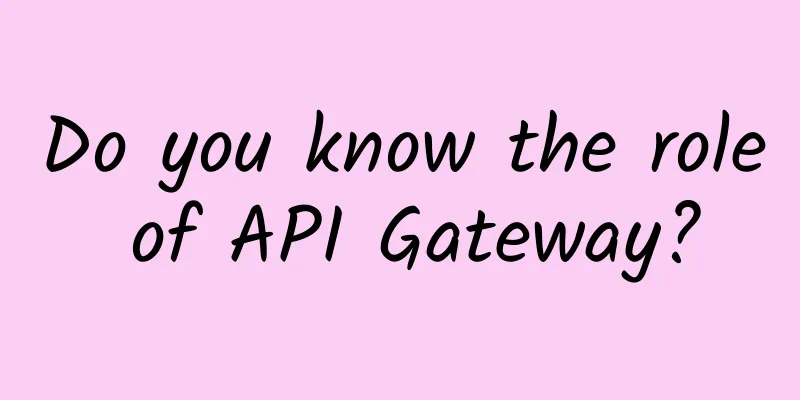Self-intelligent network, intent-driven?

|
Hello everyone, I am Jun Qiu. In this issue, we will discuss the "intention-driven" self-intelligent network. Before we begin, let’s take a look at the story about Monkey King’s weapon in Journey to the West - the Ruyi Jingu Bang. Well, let’s start now. "Ruyi" Golden Hoop Wukong looked up at the Dinghaishen iron rod which was as thick as a bucket and weighed 13,500 kilograms, and scratched his head: It would be better if it could be lighter and smaller. As soon as he finished speaking, the magical weapon actually became smaller and lighter. Wukong was overjoyed: Lighter, smaller! In the end, the "Dinghai Shenzhen Iron" standing on the seabed turned into the "Ruyi Jingu Bang" that could kill people in all directions. When not in use, it could also turn into an embroidery needle and be placed in the ear. It can be said to be driven by intention and has countless changes. Yes, the golden hoop stick is like it has intelligence, and you can just give it commands without any instructions on the details. The performance of the Ruyi Jingu Bang has never disappointed Wukong. The meaning of "intention-driven" to self-intelligent networks is similar to that of the Ruyi Jingu Bang to Wukong. What can “intent-based networking” do?In the field of communications, the concept of self-intelligent networks has emerged in recent years: the network is highly autonomous and intelligent, and can self-plan, self-deploy, self-optimize, and self-evolve. In a self-intelligent network, people only need to tell the network their intentions, and the network will automatically develop the best solution and automatically execute the task. People only need to check and accept the results at the end. This is called "intention-driven", and a network with such capabilities is naturally called "Intent Based Networking (IBN)". For example, users in a building have recently been complaining about poor 5G signals and slow network speeds. It seems that it is necessary to promote the construction of indoor coverage. So you shout and issue instructions on the network background: I want to build a 5G indoor distributed system in this building, please come up with a plan! After that, all you have to do is light a cigarette, watch a video, and wait for the planning results. At this time, the network is very busy. It must fully consider the following issues: Where is the building located and how many VIP users are there in it? How much call traffic is there and how is it distributed between floors? It is also necessary to combine the cost-effectiveness of various options for network planning. Sure enough, within a cigarette break, the report came out: it recommended upgrading the existing 4G indoor distribution system to 5G, and then adding digital indoor distribution in some hot spots. It also clearly stated how many new devices would be needed, and what the coverage and capacity would be after the construction was completed! From the above example, we can see that with intent-based networking, everything will be so worry-free and labor-saving. Let's take a look at how the industry defines this concept. Intent-driven: The foundation of self-intelligent networksThe concept of "intent" was first introduced by the IETF (Internet Engineering Task Force) in 2015 in the context of SDN controllers. The IETF defines intent as: "an abstract, high-level policy for operating a network." This definition seemed a bit unclear, so the IETF patched it again in 2020: "A set of operational objectives that the network should meet and the results that the network should deliver, defined in a declarative way without specifying how to achieve or implement them." Intent-driven, essentially, reflects the view of humans as external supervisors of autonomous systems. They expect the system to meet their needs. The system must meet their expectations, and intent is the expression of their needs. If we translate it into plain language, it means: I hope the network is like this. And I don’t care about the process, I only care about the result! The concept of "intent-based networking" was proposed by Gartner in 2017. Gartner wrote in its official blog: Intent-based networking is not a product or a market. It is a network software that helps plan, design, implement/operate networks, thereby improving network availability and agility. Intent-based networking mainly consists of the following four parts: 1. Translation and verification: The system obtains higher-level business policies from end users and translates them into the necessary network configuration, generating and verifying the final design and configuration to ensure correctness. In layman's terms: What should be done? How to do it? Figure it out! 2. Automated implementation: The system can configure appropriate network changes on the existing network infrastructure, which is done through network automation or network orchestration. In layman's terms: moving bricks, efficient and automated moving bricks! 3. Network status perception: The system obtains the real-time network status under its management and control. In layman's terms, it means: evaluate how well the work is done and whether it is acceptable. 4. Assurance and automated optimization/remediation: The system continuously verifies that the original business intent is being achieved and can take corrective action when the desired intent is not being achieved. In simple terms: rework and make minor repairs, and if it really doesn't work, start over again. From the above four points, it can be seen that intention is the starting point and end point of various operations in the network. According to relevant research reports, the deployment of intent-based networks can reduce network infrastructure delivery time by 50%-90%, and can also reduce the number and duration of downtime by at least 50%, greatly improving network availability and agility. It can be seen that the industry is full of confidence in this. As we all know, with the introduction of 5G, multi-frequency and multi-standard networks have made the network more and more complex. Various toC and toB business needs vary, and a large number of terminals of different types and capabilities are accessed. The operations of each link such as planning, construction, maintenance, optimization and operation have extremely high requirements on manpower. If the network is completely operated manually, the efficiency will undoubtedly be very low, and the quality of task completion depends to a large extent on the ability and experience of the personnel, and the probability of error is very high. We go a step further and use pre-written and tested scripts to automate operations, which will undoubtedly bring huge improvements in efficiency. But in this approach, key decision points still rely on human experience, because the automated system has no idea what to do when it encounters a problem and must be upgraded for human support. The reason why we strive for network autonomy is to maximize the network's reliance on human resources. To achieve network autonomy, it must be intelligent enough to proactively solve problems and optimize solutions based on the principle of maximizing utility. At this point, the network becomes a black box. We cannot perform micromanagement on its behalf. We do not need to figure out how each parameter inside the network is configured, nor do we need to spend a lot of effort analyzing whether the network indicators satisfy users. We only need to clearly express our intentions to the network, and the network will take care of the rest. In other words, in a self-intelligent network, intent is the natural way of interaction between people and machines, and between machines, and it is also the most efficient way of interaction. Intent-based networking shields the technical complexity of the underlying network, allowing operation and maintenance personnel to focus on the value of the network itself, and also making the interaction between various business domains simpler. As can be seen from the figure above, the information interaction between different domains and layers of the self-intelligent network is all driven by intent. Service operation issues orders to resource operation through resource intent; business operation issues requirements to service operation through service intent; and end users realize their demands by expressing business intent to business operation. TM Forum: Intention in Self-Intelligent Networks "Intent-driven" is essentially a conceptual innovation in network governance. It is built on artificial intelligence and is the foundation of self-intelligent networks. The human-machine interface for intention input generally uses voice or text input, which first requires an important branch of traditional artificial intelligence: natural language understanding. After that, key actions such as intelligent arrangement of network resources, troubleshooting of network management, and network performance optimization all require the participation of big data and artificial intelligence algorithms. In this golden age of artificial intelligence development, "intention" will surely drive self-intelligent networks to shine, allowing the network to move according to "intention" like the Ruyi Jingu Bang and empower all parties. |
<<: A Brief Analysis of TSN Time Sensitive Network Technology
>>: The battle for Wi-Fi 7 is about to begin
Recommend
edgeNAT is 30% off on Double 11, and you can apply for 50% off when you top up 500 yuan. Hong Kong/Korea/US CN2 is available
edgeNAT is a Chinese VPS host established in 2019...
V.PS: €9.95/year VPS with new German data center, 1G memory/15G SSD/1TB monthly traffic
The Nano series provided by V.PS adds a German da...
Review: China ranks first in 5G mobile phone sales, is the world happy too?
After the Spring Festival of the Year of the Ox, ...
CMIVPS: Hong Kong VPS with 20% off monthly payment and 30% off annual payment, large bandwidth, direct connection line
CMIVPS is a Chinese hosting company founded in 20...
How people cope with self-managed data centers
Self-managing data centers, sometimes called self...
Quickly understand the characteristics and differences of HTTP1.0 1.1 2.0 3.0
HTTP1.0 HTTP version 1.0 is a stateless, connecti...
The 5G era is accelerating. When will edge computing replace "core" computing?
In the 5G era, the number of connected devices wi...
Universal crawler techniques: How to properly remove invalid parameters from URLs
We know that a URL consists of the following part...
ZJI: 580 yuan/month 2×E5-2630L, 32G memory, 480G SSD, 10M bandwidth, Hong Kong Confederation data center
ZJI is a well-known hosting company in the WordPr...
Review of 5G industry-specific networks in 2020: The beginning of a new era
4G changes life, 5G changes society. As the leade...
CloudCone: $69/month-E3-1270v2, 32G memory, 512G SSD, 100M/1Gbps bandwidth, Los Angeles MC data center
We often share information about VPS hosts provid...
A brief discussion on IPv6 intrusion and defense
Preface Recently, some customers started the tran...
Wu Hequan: The proportion of IPv6 traffic in domestic applications still needs to be improved
At the "2020 China IPv6 Development Forum&qu...
Clarity: Docker's four network modes
1. Closed container closed network mode It is equ...
How eSIM is revolutionizing wireless technology
Embedded Subscriber Identity Modules (eSIMs) have...









